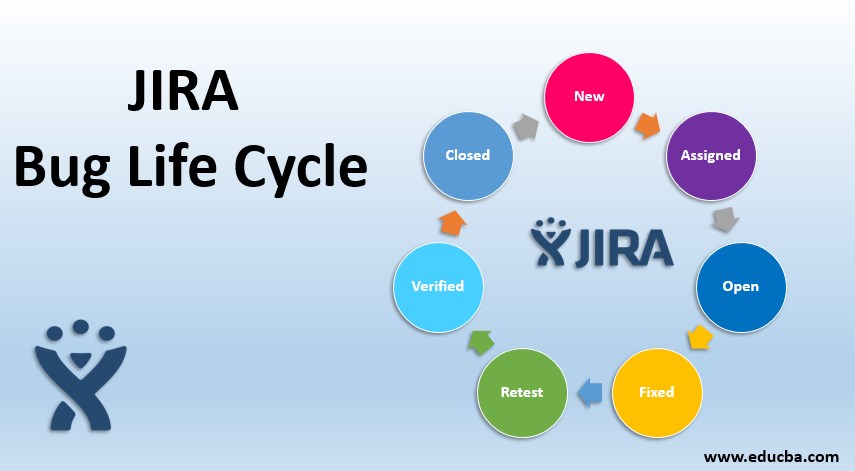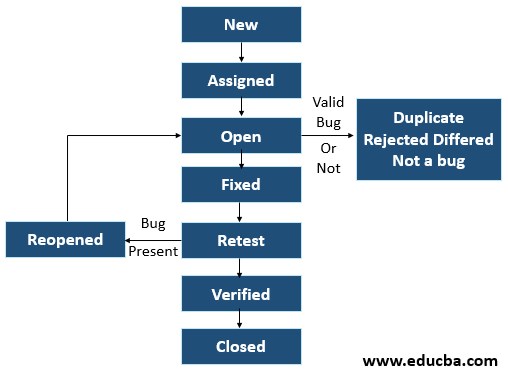Updated March 24, 2023

Introduction to JIRA Bug Life Cycle
JIRA Bug Life Cycle or Defect Life Cycle is a cyclic process, which describes how a defect or bug passes through different stages from the identification stage to the Fixing stage i.e. it begins when a tester finds or logs a bug and it ends when the bug is fixed. The total process is done through the JIRA tool, which is a commercial issue or bug tracking tool developed by Atlassian, It is commonly used for bug tracking, issue tracking, and project management. It is the process of the report, resolve the bug and to track the status of it.
JIRA Bug Life Cycle
The Bug Life Cycle consists of different stages through which a Bug is resolved, tests the bugs and follows the process until the bug exists.
The stages in the JIRA Bug Life Cycle are given below:
- New
- Assigned
- Open
- Fixed
- Retest
- Verified
- Reopen
- Closed
Block Diagram of JIRA Bug Life Cycle
1. NEW: When a bug or defect is found in an application by the tester during the testing phase then, it is reported to the development team through the bug management tool JIRA.so the initial level of bug status is assigned by the tester as a “NEW”. Here the tester creates an issue in JIRA by describing the Issue type, summary, description, priority, etc of the bug.
2. ASSIGNED: Once a new status bug is raised by the tester, then the technical/QA leads to validate it and assign the bug to a particular developer in the development team to work on that. Then the status of the bug is marked as “ASSIGNED” i.e. bug is approved by the developer and they will work on it to fix the bug. It is really an issue but when the developer accepts it, it changes to Bug.
3. OPEN: In this phase, once the tester assigns the bug or defect to the developer, they investigate it and resolve it. The status of the bug or defect is shown as “OPEN”. Bug fixing gets started in this phase.
The bug or defect can be passed in four stages:
4. Duplicate: If the bug is already logged before by tester or similar to the previous one, then the developer mentions the status of the bug as “Duplicate”.
5. Rejected: If the bug which was assigned to the developer is not an authentic one, then the developer mentions the status of the bug as “Rejected” with proper reasons.
6. Deferred: If there is a bug but no need to fix in this sprint/release or it is not in project scope and it can be moved to the next release for the fix, then developer mentions the status of the bug as “Deferred”. It is a postpone state.
7. Not a Bug: If the bug does not affect the functionality of the application, then the status of bug assigned as “Not a Bug”.
8. FIXED: When the developer takes necessary actions on coding to fix the defect then it changes the status of a bug as “FIXED” i.e. the defect will remove from the application.
9. RETEST: Once the bug is fixed by the developer, then assign to the testing team to check whether the bug has fixed by the developer or not and the status of the bug as “RETEST”.
10. VERIFIED: The bug is fixed by the developer, then the tester retest the application, if there is no bug then it changes the status assigned as “VERIFIED”.
11. REOPEN: The tester will do a retest of the application after fix bugs by the developer, during that if there is a bug (either a new bug or old bug not fixed), then tester assigned status as “REOPEN” i.e. once again it goes through the bug life cycle.
12. CLOSED: If there is no more bug or issue in the application after a retest, then the status will be assigned as “CLOSED” by the tester.
Note:
- The workflow or movement of the bug or issue through various stages during the life cycle in JIRA having mainly three status states. Such as:
- Create / Open /To Be Done
- Work in Progress
- Completed / Closed /Done
- The JIRA is one of the best commercial Tool to manage the project, manage the sprint, manage the bug and manage the test cases.
- It is a commercial tool which means not free of cost i.e. we paid for that tool.
- In JIRA bug life cycle, once the bug is deferred then the tester to check whether the bug related to application scope or not.
- Any deviation between the actual and expected value is called Issue or Error, if it is accepted by the developer is called “BUG”.
- There are multiple participants in JIRA bug life cycle, like Bug finder(Normally Tester who can find the Bug), Bug management tool(JIRA or Bugzilla), Bug status group(Tester, Developer, Project Manager, QA Manager, Product Owner), Bug owner(who own the bug to fix it within time limit).
Conclusion
In this article, we discuss the JIRA Bug Life Cycle in which a bug or issue can handle from the initial stage to the fixing stage. JIRA was built to track and manage bugs in software development but it has expanded to help teams plan, sprint plan and track all aspects of the software development cycle. The JIRA and Bugzilla are mostly preferred by the IT organizations to manage the project and track the status of software. It provides a better flexibility workflow and prioritizes the tasks.
Recommended Articles
This is a guide to the JIRA Bug Life Cycle. Here we discuss the overview of JIRA Bug Life Cycle and its stages along with Block Diagram respectively. You can also go through our suggested articles to learn more –


